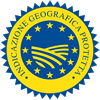Description
Melannurca Campana PGI refers to the fresh apple belonging to the Malus communis Lam. Species, deriving from the Annurca and Rossa del Sud ecotypes.
Production Area
The production area of Melannurca Campana PGI is within the territory 137 municipalities in the provinces of Avellino, Benevento, Caserta, Naples and Salerno, in the Campania region.
Production Method
In order to achieve the correct pollination, the presence of varieties other than the Annurca and Rossa del Sud is permitted up to a maximum of 10%. Harvesting is carried out by hand and the fruit are placed on the ground in the so-called melai, small plots of land with a width of no more than 1.50 m, where they are subjected to the traditional “reddening” treatment. This process is mandatory for both varieties and consists of placing the apples on layers of various soft materials, so that the less coloured part of the fruit is exposed to the light by turning them periodically. Each plot is protected with an anti-hail net that also acts as a defence against direct sunlight, which could irrevocably damage the fruit. This stage lasts from 20 to 50 days and not beyond December 15th. The maximum consented yield is fixed at 45 tons per hectare, even with the annual climate variables.
Appearance and Flavour
Melannurca Campana PGI is a medium-small sized fruit, with a rounded, flattish or short truncated-cone shape. The rind has a yellow or greenish-yellow colour (depending on the variety), with reddish hues. The fruit is characterised by a rusty-coloured area near the peduncle. It has juicy flesh which is firm, crunchy, slightly sour and aromatic, with an excellent flavour.
History
Melannurca Campana PGI’s extremely ancient ties to the Campania region are demonstrated by its appearance in paintings found during excavations at Herculaneum, and in particular in the Casa dei Cervi. It most probably originated in Pozzuoli, as described in Naturalis Historia by Pliny the Elder. In fact, due to the fact that it came from Pozzuoli, Pliny named it Mala Orcula, as it was produced near Orco, in the Averna Lake, which was considered to be the location of the Underworld. Gian Battista della Porta also described the apples produced in Pozzuoli in his work Suae Villae Pomarium, referring to them as being commonly known as orcole. From here on the names anorcola and annorcola were used, until in 1876 the name Annurca was officially used in the Manuale di Arboricoltura by G. A. Pasquale. Traditionally cultivated in the areas of Vesuvius and the Phlegraean Fields, the Melannurca gradually spread throughout Caserta, where it easily took root due to the particularly suitable soil.
Gastronomy
Melannurca Campana PGI should be kept at a low temperature, although the product is best eaten at room temperature. It is perfect as a fresh fruit, as it is rich in nutritional substances, although it is also an excellent ingredient for the preparation of fruit juices, liqueurs, tarts and desserts filled with ricotta and candied fruit, as well as for traditional oven-baked apples.
Marketing
The product is marketed as Melannurca Campana PGI in the following varieties: Annurca and Rossa del Sud. It is sold individually, in boxes or wrapped with clear labelling indicating the product details.
Distinctive Features
The most unusual aspect of Melannurca Campana PGI is found in the production method: the apples are picked before they are fully ripe, when the skin is still green, and left to “redden” on the ground. In this way, the fruit acquire their typical red colour thanks to the natural light and the expertise of the farmers in turning the fruit.





































